

Stanford's Kelley Discusses `Design Thinking': Video. Comparison between Transformative and Informative learning methods. An educational system isn’t worth a great deal if it teaches people how to make a living but doesn’t teach them how to make a life. ~ Author Unknown.
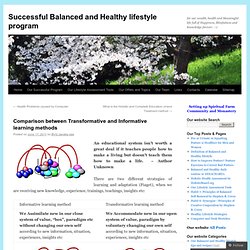
Fostering a Climate Conducive to Transformative Learning. January 17, 2012 By: Joyce Henderson, EdD in Online Education It’s thrilling when I, as an educator, witness a student’s transformation from a limiting perspective to one that is broader, more inclusive, and most times empowering and inspiring.
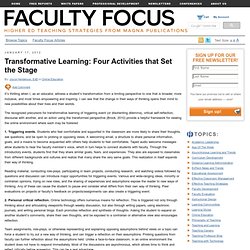
I can see that the change in their ways of thinking opens their mind to new possibilities about their lives and their worlds. The recognized precursors for transformative learning of triggering event (or disorienting dilemma), critical self-reflection, discourse with another, and an action using the transformed perspective (Brock, 2010) provide a helpful framework for viewing the online environment where each may be fostered. 1. Transformative learning. Defining a Transformational Education Model for the Engaged University. A Wisconsin Perspective on Transformational Education Transformational Education is the conceptual model that Wisconsin's Cooperative Extension Service (CES) uses to work with communities tackling complex issues in ways that transform these same communities in powerful and long-lasting ways.

Transformational education recognizes the importance of building trusting relationships with partners (Ayers, 2006; Covey, 1989), bringing scholarship that draws upon both university and local knowledge and expertise to public issues (Peters, Jordan, Adamek, & Alter, 2005), and building the capacity of individuals to engage in problem solving or taking actions with the "creative implementation of a purpose" (Mezirow, 1991). Transformational education exemplifies the Kellogg Commission's (1999) notion of the engaged university--publicly supported universities partnering with individuals and communities in a participatory process.
From Service to Transformational Education Figure 1. Redefining the Model. The Journal of Applied Instructional Design. ID Demo. Kirkpatrick's Four-Level Evaluation Model in Instructional Design. Perhaps the best known evaluation methodology for judging learning processes is Donald Kirkpatrick's Four Level Evaluation Model that was first published in a series of articles in 1959 in the Journal of American Society of Training Directors (now known as T+D Magazine).
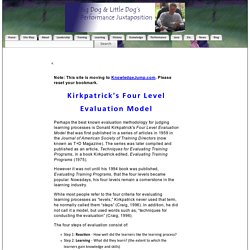
The series was later compiled and published as an article, Techniques for Evaluating Training Programs, in a book Kirkpatrick edited, Evaluating Training Programs (1975). However it was not until his 1994 book was published, Evaluating Training Programs, that the four levels became popular. Instructional Systems Development Opportunities at ASTD 2012. Need to learn more about Instructional Systems Design, but don't know where to start?
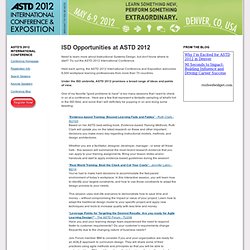
Try out the ASTD 2012 International Conference. Held each spring, the ASTD 2012 International Conference and Exposition welcomes 8,000 workplace learning professionals from more than 70 countries. Under the ISD umbrella, ASTD 2012 promises a broad range of ideas and points of view. One of my favorite "good problems to have" is too many sessions that I want to check in on at a conference. The ADDIE Design Phase. The ADDIE Development Phase. The ADDIE Evaluation Phase. The ADDIE Analysis Phase. Instructional or Learning Design Framework. This section describes a Framework for designing learning environments.

It includes two templates (Excel workbooks) that aids in the instructional design. While the two spreadsheets are discussed at the end of this article, you might want to download them now and look them over as both further explain the concepts listed in this article. This Learning or Instructional Design Framework is built on three models: Instructional Design. Rubrics for Teachers - Assessment.
Learn more about our Online Courses, Online Certificate Programs, and Graduate Degree A collection of rubrics for assessing portfolios, group work/cooperative learning, concept map, research process/ report, PowerPoint, oral presentation, web page, blog, wiki, and other social media projects.
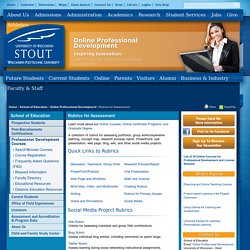
Quick Links to Rubrics Social Media Project Rubrics Wiki RubricCriteria for assessing individual and group Wiki contributions. Blog RubricAssess individual blog entries, including comments on peers' blogs. Twitter RubricAssess learning during social networking instructional assignments. Discussion, Teamwork, and Group Work Rubrics Online Discussion Board RubricAssessing ability to share perspectives, refine thoughts through the writing process, and participate in meaningful discussionPrimary Grade Self-Evaluation Teamwork Rubric (PDF)Features of a sandwich to graphically show the criteria. National Dental Examining Board of Canada. Constructivism Learning Theory. Constructivism Learning Theory Constructivism learning theory is a philosophy which enhances students' logical and conceptual growth.

The underlying concept within the constructivism learning theory is the role which experiences-or connections with the adjoining atmosphere-play in student education. The constructivism learning theory argues that people produce knowledge and form meaning based upon their experiences. Two of the key concepts within the constructivism learning theory which create the construction of an individual's new knowledge are accommodation and assimilation. Assimilating causes an individual to incorporate new experiences into the old experiences. Constructivist Learning Design Paper.
Teachers and teacher educators make different meanings of constructivist learning theory.

At a recent retreat with facilitators of learning communities for teachers who were studying in a Masters of Education program, we were talking about our common reading of The Case for Constructivist Classrooms (Brooks & Brooks, 1993). We asked the ten facilitators to answer this question, "What is constructivism? " The results were interesting because all of their definitions were quite different and reflected their own understanding of the term and the text. This was a clear demonstration that what we read does not produce a single meaning but that understanding is constructed by the readers who bring prior knowledge and experience to the text and make their own meaning as they interact with the author's words.